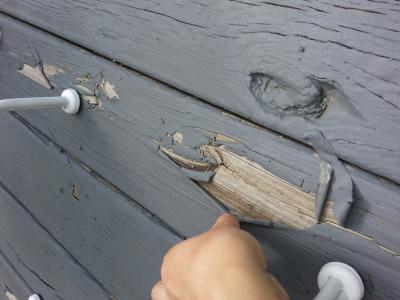 Since we’ve completed numerous deck staining projects over the years, we’ve seen many homeowners dissatisfied with their decks. Stains that don’t look as good as expected or don’t last too long are two complaints we come across way too often.
Since we’ve completed numerous deck staining projects over the years, we’ve seen many homeowners dissatisfied with their decks. Stains that don’t look as good as expected or don’t last too long are two complaints we come across way too often.
If you’re fed up with staining your deck every year, the time has come to identify the root cause of the problem prior to applying a new coat or finish. In most cases, stains peel off due to:
- Poor prep: Poor preparation work is one of the few reasons why your stain peels off shortly after being applied. Before you stain a deck, you should: use a good-quality deck cleaner to remove dirt and graying (don’t use chlorine-based products, as they damage the structure of the wood); apply the right deck finish remover to get rid of the previous coating; get a high-quality deck brightener to neutralize residues left behind by the cleaner and finish remover; and use coarse sandpaper to provide a uniform surface and make the wood more porous for better stain absorption.
- Wrong type of stain: When choosing stain, check if it’s specifically designed for exterior wood deck. Also, remember that coatings that are too thick typically form a film on the surface without penetrating into the wood, which makes them more prone to peeling.
- Improper weather conditions: High temperatures and excessive humidity are two “improper weather conditions” for staining. If you plan to stain a deck under Florida’s direct sunlight at noon, for instance, the product will dry too quickly and leave unsightly marks. The ideal temperature for staining decks is between 50°F to 90°F. Also, don’t apply stain after it rains. The moisture trapped inside the wood may hamper stain absorption into its fibers, eventually causing it to peel off.
- Over application: People often wrongly assume that applying one or two more coats will make the stain more durable. In fact, oversaturating the wood will result in a thick film on the surface, which will flake and peel away within a few weeks or months.
Now that you know what deck finishing pitfalls to avoid, let’s focus on the products you should use next time you stain a deck to further prevent stain from peeling.
Brighteners
Using brighteners isn’t only very easy (you just need to spray them on, let them sit for a few minutes, and then rinse the surface), they also have a dramatic effect on the final result. Besides neutralizing the chemicals left behind by deck cleaners and finish removers, wood brighteners open up the wood grain to improve stain absorption, providing a more uniform look and preventing the stain from peeling off.
Stains
To begin with, there are two main types of deck stains: 1) penetrating finishes that soak into wood; 2) film-forming stains that penetrate the wood only slightly and form a film on the surface, just like urethane-based products or varnishes. As film-forming stains don’t penetrate the wood, they’re more susceptible to peeling than penetrating coatings. Another important thing is quality. Many inexpensive wood staining systems have a history of poor performance and failure. To enjoy your beautiful deck for a long time, ensure that the product you intend to use to stain a deck is of high quality.
It’s also worth considering water-based stains. Though many homeowners and professionals are still reluctant to use such products, we’ve successfully completed many projects with water-based finishes. Typically, these stains perform better and last longer than some conventional staining products; contain no harsh chemicals, so they’re easy on the environment, pets and people; and provide a breathable topcoat, which means that you can stain a deck even if the wood isn’t completely dry. Since high humidity is a significant problem here in Florida, we advise you to use water-based stains with synthetic resins, which are less prone to mold growth.
Deck sealers
After preparing your deck for sealing, you can also apply a waterproofing deck sealer. Since this product will repel water much better than a regular stain, it can prolong the life of your deck.
Depending on the decking material and type of finish, you may also need to apply a primer. You can find a variety of primers intended for use on decks prior to staining or sealing the surface.
When applying the stain or sealer, always follow the manufacturer’s recommendations and use a natural bristle brush. Unlike other brushes, natural bristle brushes allow you to properly work the product into wood fibers.
If you’re looking for additional expert advice on staining or sealing wood, pressure washing your home’s exterior and surroundings, painting your home or installing epoxy flooring, subscribe to our FREE email newsletter or contact our knowledgeable and experienced staff at (904).641.4800.






